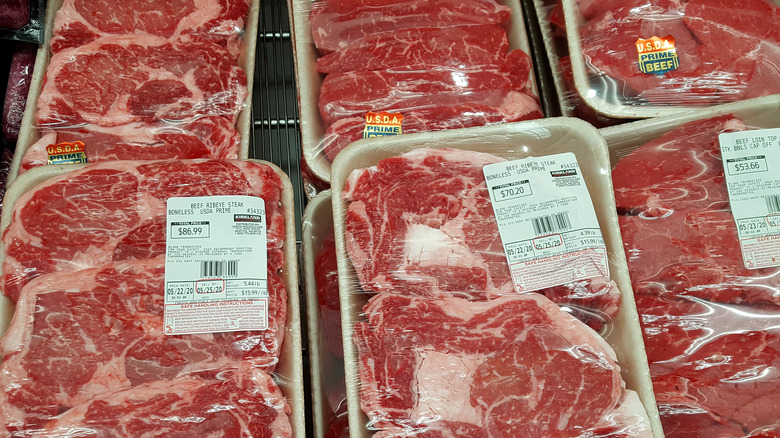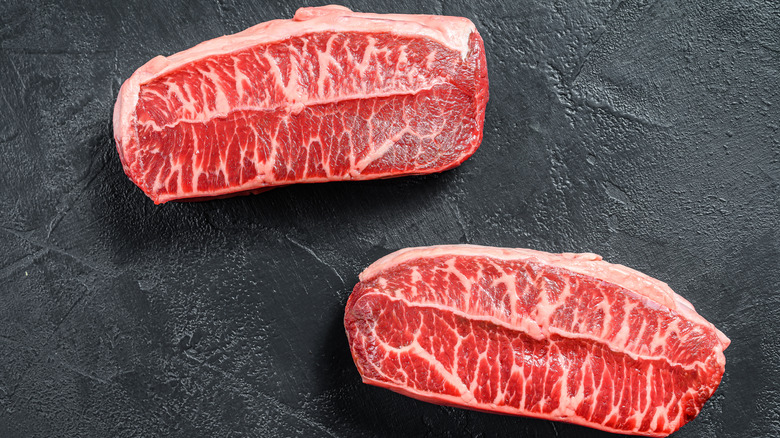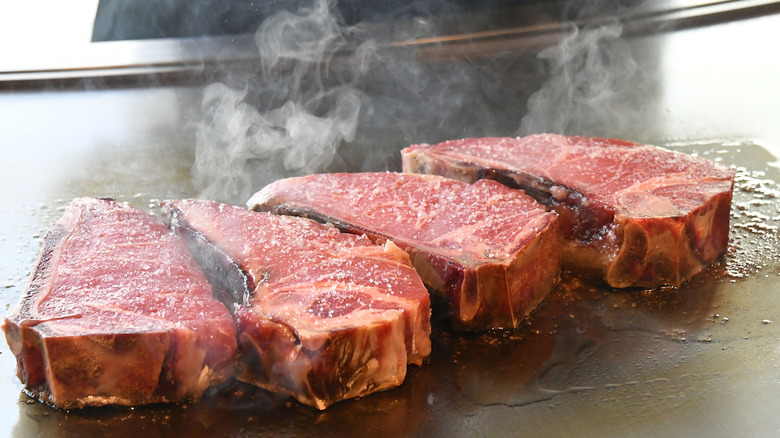The US Grocery Chain That's An Unlikely Spot To Pick Up Prime Beef
When dining out at a nice restaurant, there's often a certain magic to steak that feels irreplaceable at home. Indeed, steakhouses transform standard beef into truly delicious creations through methods like dry-aging and incredibly hot grills. However, there's another — no less important — component to the flavor, and that's the grade of beef used. Upscale restaurants and hotels are the predominant consumers of prime beef, deemed the best meat grade by the U.S. Department of Agriculture (USDA).
These cuts are well-regarded due to their excellent fat marbling, which lends an especially tender texture. Such beef comes from younger animals, which typically are fed an improved diet to achieve such a fatty consistency. Prior to sale, federal inspectors examine the beef, and then subsequently assign the grade. The exact amount of U.S. beef that's deemed quality enough for prime can vary year by year, but it's usually 10% or less of the country's meat supply according to the USDA — and its understandably coveted nature means prices are high.
At one point, prime beef was known to be mostly allocated to commercial kitchens, but now it's also sold at a familiar retailer: Costco. You can find a range of prime cuts at the store (when they're in stock), with everything from tenderloin to sirloin to a whole rack of ribs. Sure, it's a little pricier, but it also brings steakhouse-quality cuts into your home kitchen. And you can easily purchase such delights during your weekly grocery run.
Prime beef is more available to shoppers than it used to be
Prime beef's availability at Costco comes alongside changes in the industry that offer consumers in the United States more access to high quality cuts, with several major retailers opting to distribute steaks with better grades. Largely, this shift is due to the greater percentage of beef marked as prime from the late 2010s onward. In the past, it was commonly stated among industry pros that less than 2% of American beef was given the grade (via Serious Eats), although the figure is now more than doubling. More cows are labelled prime year-round, when in prior times, the grading used to be a more seasonal affair. This trend is due to several factors, with alterations in grading and genetics as prominent contributors. Bolstered by the market's expansion, this special marbled beef is now perfectly poised for home cooking applications.
For home cooks, prime beef was once confined to specialty butchers, but now it's also available at Albertson's and can sometimes be purchased online, too. Don't worry, you haven't necessarily been accidentally walking past prime cuts at Costco for years. Not all Costco locations carry the same items in stock, so it's possible that your local Costco doesn't stock prime beef or only offers it occasionally.
Know the limitations of purchasing prime beef
Prime beef is undeniably a tasty cut, and when deftly prepared, it seldom disappoints. However, as with any pricier culinary purchase, it's helpful to know the details. First of all, not all beef sold on the U.S. market is categorized by the USDA. In fact, sellers voluntarily opt-in and pay to participate in the program, so a well-marbled ribeye from your neighborhood butcher that isn't graded might still fit the quality bill.
Additionally, beef grading varies per country, and the United States has one of the less comprehensive systems. Grading is based nearly entirely around marbling density, leaving out the type of fat, the cow breed, age, and such factors that contribute to taste. There's a flavor difference between grass-fed and grain-fed beef, a distinction not accounted for by the USDA. In fact, many diners actually prefer both older and grass-fed cows, two factors that lead to worsened marbling. So although prime does offer some quality indicator, it's not an end-all.
Note that such marbled cuts aren't necessary for all applications — don't bother buying high-quality beef for a delicious braise. Instead, prime cuts are worth the splurge for steak cuts that could use a little extra fat, like a New York strip or sirloin. So while you may not pick up a package of such steaks from Costco for a grill-out and enjoy — it'll transfer a part of the steakhouse experience to a domestic setting.


